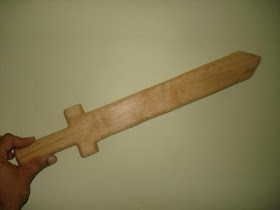 |
| Wooden dominoes |
Well I decided to make wooden dominoes. It was to be a gift.
A lot of my inspiration was from
Mathias Wandel's dominoes. He made it look so easy.
Failed attempts
I tried using 10 mm thick beading. However the beading was slightly uneven and also was slightly warped. I gave up on it. I also tried cutting a whole block of neem, but my table saw blade was not high enough. I finally used a beam of wood that I cross cut.
Wood :
Padauk wood (Padag) wood. The lady who owned the the local timber mill was very helpful. I asked her for the darkest wood she had, and she fished out this wood. It was nice and red. I got this planed at the lumber mill itself as a long beam about 2.5 inches by 1.5 inches or so. I planned to use this such that I could cut a cross section of the beam and get a single domino. I actually misjudged the size a bit, and had to trim down each domino later. But that was not so much of a problem.
Cutting the dominoes : I used my home made circular saw made into a table saw. I also had a simple cross cut jig to help me cut the dominoes. It worked pretty well.
 |
My son Arpit enjoys vacuuming cleaning up sawdust. Seen here is my table saw
and the cross cut jig. The long belt of sandpaper that I used to sand paper the
dominoes is also seen.
|
Trimming them. I used a stop block on my cross cut sledge to trim all dominoes to the final size.
Sanding : I got fine saw marks on the cross cut surface. These lines are not so important when one is making something large. But for dominoes they really stand out. So I had to sand both sides of the dominoes. I tried my orbital sander but this was not fast enough. I wished I had a belt sander. I finally went to the local store and bought one meter of sanding belt paper. I fixed this on my table with two clamps and then sanded the raw domino on this. This was useful as I was able to apply my body weight on the domino thereby hastening the process. I sanded along the grain and used finer sand paper to get a smooth finish.
Template: I used microsoft powerpoint to get an accurate size of the domino with the spots. I printed out a whole set of double sixes. I then cut them out (actually my wife and son did this) and stuck them on the blocks.
 |
| template for dominoes that I printed out from Power Point |
Making the spots : I used a drill press and a 6 mm drill bit to drill the holes. They were not really accurate but were passable. I then sanded off the paper.
 |
| Drilling the domino holes with a drill press |
Using a plug cutter, I cut out plugs of thin finger jointed wood.
 |
| Cutting domino plugs from finger jointed rubber with a plug cutter bit |
 |
| Arpit enjoyed counting the small plugs. A total of 150 or so were needed. |
I stuck the plug into each of the holes and then sanded them flush when dry.
 |
| Unfinished dominoes in different stages |
Center line : I made the center line with a file.
Finish : Clear varnish. But I did not want the glossy look so I wiped off the varnish immediately after applying it. It gives a dull finish.
 |
| Wooden domino box |
Box : I made a box out of finger jointed wood. I tried some techniques for the joints. I was able to round over the edges using my router table.
Finished product : I liked the contrasting colors that I was able to get without any stains. I have to work on my box making skills. The dominoes topple well. However they are not perfectly square so you cannot stack three or four of them vertically one over another.
 |
| Wooden dominoes in box |



















